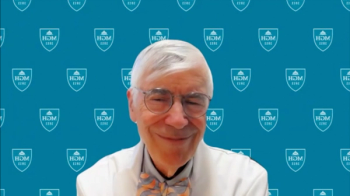
Dr Elisabet Manasanch: Flow Cytometry, Sequencing Optimal for Assessing MRD
Some of the best ways to assess minimal residual disease (MRD) are using flow cytometry or using sequencing, said Elisabet Manasanch, MD, assistant professor in the Department of Lymphoma/Myeloma and Division of Cancer Medicine at The University of Texas MD Anderson Cancer Center.
Some of the best ways to assess minimal residual disease (MRD) are using flow cytometry or using sequencing, said Elisabet Manasanch, MD, assistant professor in the Department of Lymphoma/Myeloma and Division of Cancer Medicine at The University of Texas MD Anderson Cancer Center.
Transcript
What do we know about the best ways to assess MRD accurately?
So, some of the best ways to assess MRD are using flow cytometry or using sequencing. Some of the advantages of flow cytometry is that it requires a sample, and it's something that labs can do in academic centers. For example, each lab or each academic center can set up their own assay. This is something that can be learned, but some of the disadvantages of this technique is that it usually requires a lot of time for you to do the assay. So, you can do flow cytometry, and you can use different colors to detect the myeloma cells, for example, and you can use different tubes, but the more cells that you have to analyze to detect the myeloma cells that are left, the harder it is to do the test. So, it could be many attempts, it could be many, many hours, for example, and that is very costly for the department that is doing this test.
Whereas for example, with sequencing, there's a price because it's a commercial assay; but it's not something that you have to have, for example, your department of pathology, do and create an assay and spend 5 or 6 hours doing the test for just 1 patient. Again, the issue with flow cytometry is that every place is different. So, in this country, they do it this way, and in other countries, they do it this way, and then in New York they do it this way, in Houston they do it this way, and in LA it is this other way. So, everyone has a little bit of their own assay that they do, and what we just have to be careful is the sensitivity and I think that's something that people are aware of.
The nice thing with sequencing is that it's basically DNA sequencing. So, then it's the same almost everywhere, and also there are commercial assays that is the same message—you send the sample to a centralized location. They do the test, and of course, it's a centralized location. So, the test is going to be the same whether you send the sample from New York, Houston, or LA. So, those are like the different tests, but I would say if you are a physician in the community, and you don't have access to a very good flow cytometry lab that can do a lot of sets, you can just probably send the commercial assay and that way you can tell your patient what is the response that they have, and that's something that you just have to draw an extra sample and then ship it. So, that would be my basic recommendation, if you don't have access to these labs that do the advanced flow cytometry testing.
Newsletter
Stay ahead of policy, cost, and value—subscribe to AJMC for expert insights at the intersection of clinical care and health economics.




























































